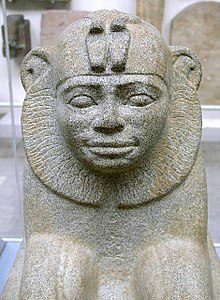Taharqa
| Taharqa | |
|---|---|

Granite sphinx of Taharqa from Kawa in Sudan
|
|
| Pharaoh | |
| Reign | 690–664 BCE (25th dynasty) |
| Predecessor | Shebitku |
| Successor | Tantamani |
| Consort | Great Queen Takahatenamun, Atakhebasken, Naparaye, Tabekenamun |
| Children | Amenirdis II, Ushankhuru, Nesishutefnut |
| Father | Piye |
| Mother | Abar |
| Died | 664 BC |
Taharqa, also spelled Taharka or Taharqo (Biblical Tirhaka or Tirhaqa, Manetho's Tarakos, Strabo's Tearco), was a pharaoh of ancient Egypt of the Twenty-fifth Dynasty and qore (king) of the Kingdom of Kush.
Taharqa was the son of Piye, the Nubian king of Napata who had first conquered Egypt. Taharqa was also the cousin and successor of Shebitku. The successful campaigns of Piye and Shabaka paved the way for a prosperous reign by Taharqa.
Taharqa's reign can be dated from 690 BC to 664 BC. Evidence for the dates of his reign is derived from the Serapeum stela, catalog number 192. This stela records that an Apis bull born and installed (fourth month of Peret, day 9) in Year 26 of Taharqa died in Year 20 of Psammetichus I (4th month of Shomu, day 20), having lived 21 years. This would give Taharqa a reign of 26 years and a fraction, in 690-664 B.C. Taharqa explicitly states in Kawa Stela V, line 15, that he succeeded his predecessor (generally assumed to be Shebitku) after the latter's death with this statement: "I received the Crown in Memphis after the Falcon (i.e., Shebitku) flew to heaven."
Although Taharqa's reign was filled with conflict with the Assyrians, it was also a prosperous renaissance period in Egypt and Kush. When Taharqa was about 20 years old, he participated in a historic battle with the Assyrian emperor Sennacherib at Eltekeh. At Hezekiah's request, Taharqa and the Egyptian/Kushite army managed to stall the Assyrian advance on Jerusalem, with Sennacherib eventually abandoning the siege due to the loss of 185,000 soldiers at the hand of the Lord according to the Biblical account.
...
Wikipedia
